Constellations Testify of Seven Angels
Reprinted from Meridian Magazine (28 Sep 2006).
©2006 by John P. Pratt. All rights Reserved.
| 1. Heaven and Hell |
| 1.1 Sheep and Goats |
| 1.2 A Celestial Map |
| 2. Seven Angels |
| 3. 49 Constellations |
| 3.1 Seven Sisters |
| 3.2 Mapping the Heavens |
| 3.3 Perfect Pictures |
| 4. One Column Per Angel |
| 4.1 The Bright Stars |
| 4.2 Noah Presides in Paradise? |
| 5. Seven Roles Portrayed |
| 5.1 Moses |
| 5.2 Enoch |
| 5.3 Noah |
| 5.4 Peter |
| 5.5 Joseph Smith |
| 5.6 Abel |
| 5.7 Adam |
| 5.8 Twins Reversed |
| 6. Conclusion |
| Notes |
Scripture, constellations and myth combine to tell the deeds of the seven chief angels in heaven, earth and the underworld.
Last month’s article summarized how 48 constellations testify of the twelve great labors of Jesus Christ (See Figure 1).[1] That was largely a review of the past work of others, but this article introduces entirely new dimensions and original interpretations to the revelations contained in those marvelous signs which were revealed to Enoch. When 49 constellations are arranged into a 7 x 7 table according to their position in the heavens, it is here proposed that each column represents one of the seven chief angels and each of the rows represents a location in heaven, earth or the underworld. Moreover, there is a bright star in the constellation found at the location where the angel performed his greatest work. Enoch’s myths, which were partially preserved by the Egyptians, Greeks and Romans tell many of the stories. In last month’s article the “hero” constellations, such as Hercules, the Hunter, the Hero, the Herdsman, all represented Jesus Christ. He was both of the Twins and both of the Dogs. In this article, none of the constellations refer to Christ, but all of the heros are the seven chief angels of God who each do some things similar to what Jesus did. For example, one was a healer, one a shepherd, one was crucified, and two were slain like sacrificial lambs by secret conspiracies. Thus, the same figures have new meanings in a new context.
Perhaps the most surprising implication of these new interpretations is that the famous Perseus myth, upon which the movie Clash of the Titans was based, has many clear correspondences with the feats of the Prophet Joseph Smith. The reader is invited to consider the evidence which includes possible references to the first vision, the urim and thummin, and even the visit of Peter, James and John. Last month’s article mainly referred to Biblical scripture, but this one of necessity involves an excursion into doctrines revealed in these latter-days. No extensive LDS background, however, is required to understand the ideas. Let us now embark on this odyssey through a realm of scriptures, stars, and sagas, keeping in mind that all of the ideas presented are strictly those of the author and do not represent any official doctrines of the LDS Church.
1. Heaven and Hell
Because this celestial drama occurs on a stage that has three heavens, as well as paradise and two levels of hell, it would seem that an introductory explanation is in order for readers unfamiliar with LDS teachings. When the Savior taught during his mortal ministry, he kept everything very simple: those who followed him were his sheep who would inherit everlasting life and those who didn’t were the goats who would be cast out with everlasting punishment (Mat. 25:31-46). He referred to two locations for the afterlife: heaven and hell (Mat. 11:23).
In latter-day saint (LDS) belief, there are three degrees of heaven: celestial, terrestrial, and telestial, which differ in glory as do the sun, moon and stars (see D&C 76, compare 1 Cor. 15:40-41, 2 Cor. 12:2). They are presided over by the Father, the Son, and the Holy Ghost, respectively. The underworld can also be thought of as having three levels: paradise, hell, and perdition. To understand this article it is necessary to understand something about who goes to each, and when each area is in operation.
1.1 Sheep and Goats
Here is my understanding of how the sheep and goats relate to these various places. Even though children are born with pure spirits, we soon all break God’s laws and we all become goats, provided that we have the age and mental capacity to be accountable. Our loving Father sent his Son to atone for us, and if we accept his offering and obey his teachings, we can move over to his right hand and become sheep. He is extremely patient with us and gives us every chance. After people die, those who were sheep go to a beautiful place called “paradise” (2 Nephi 9:13, Alma 40:12-14), whereas the goats go to a place of suffering where they feel the fires of remorse for their poor decisions in life. The scriptures refer to both “hell” and also the “lowest hell” (Deut. 32:22, Psa. 86:13). To make a clear distinction, this article refers to the lower portion as “perdition” because those who go there are called “sons of perdition.” My understanding is that those in hell were deceived by Satan into thinking that his short-cut methods were a better choice than the Savior’s path. Their suffering comes from the realization that all of those false roads led to enslavement rather than the freedom that was falsely promised. Those in perdition, however, were not deceived. They knowingly chose to do evil and actually prefer Satan over Christ.
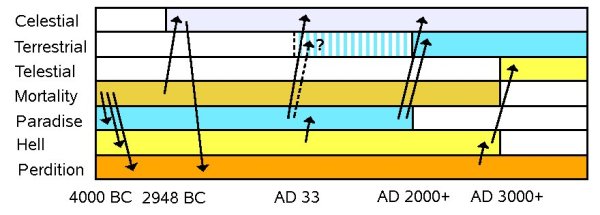 |
Figure 2 illustrates the various kingdoms and when each is populated. Since Adam, there have been people on earth, in paradise, in hell and in perdition. About 2948 BC Enoch’s people became so righteous, living the law of the highest heaven, that their whole city was taken up into heaven (Moses 7:21) and began to populate that area. By that I do not understand that they were in the presence of God because their probationary period was not over, but rather they were in a place which became a temporary celestial kingdom. The Book of Enoch implies that later some of them knowingly chose to sin and became “fallen angels,” and were relocated to suffer in the depths of perdition until the end of the world (Enoch 12:1-14:7).
When Jesus paid the price of sin and unlocked the gates of paradise, which had been like a prison even to the righteous (D&C 138:18, 50), those who qualified resurrected to the celestial kingdom. Their test was over and they had passed. Whether or not they physically joined the city of Enoch is not clear, but in the star figures both are shown as being in the highest heaven. To me it is not clear whether or not some or perhaps all of the remaining spirits in paradise then resurrected to be in the terrestrial kingdom. At least one scripture sounds like they did (Moses 7:56-57), but others might imply that all those in the terrestrial kingdom resurrect after all of those in the celestial (D&C 88:99). Hence Figure 2 shows a dashed arrow and hatched shading there to indicate that uncertainty. But we are told that while in paradise, the Savior also organized a missionary system there to teach those in hell, and give them a chance to accept his atonement and obey his teachings (D&C 138:30).
When the Savior comes again, a major event will happen. Those in paradise will be divided into two groups. Those who accepted the doctrines and ordinances of Jesus Christ are resurrected as celestial beings at the sound of the first trump (D&C 88:94-98). Those who were the honorable people of the earth who still knowingly chose not to accept all of the teachings of Christ are then resurrected into a terrestrial state at the second trump (D&C 88:99). It is not as glorious a place, but acceptable to its inhabitants where they can sit at the feet of the Savior. The earth itself will then be promoted to a terrestrial state, rather than telestial, so it becomes the temporary terrestrial kingdom. Another important point here is that after the terrestrial resurrection at the Second Coming, the doors of paradise are apparently closed and it shuts down. That is because the righteous born during the Millennium are changed in the twinkling of an eye, without sleeping in the earth (D&C 101:31).
What about those in hell? Those who accepted Christ before his Second Coming could graduate to the terrestial and even celestial kingdom. And those who did not are given yet another chance! To make the test easier (but the reward less), Satan is bound in chains after the Second Coming for a thousand years, and cast into the bottomless pit, so that he cannot deceive people into thinking that there is no God and no sin (Rev. 20:1-3). Then those in hell and perdition will have another thousand years to accept Christ, with no possibility of being deceived. At the end of that period there is a final Judgment Day. Those who have at last chosen to become sheep are then resurrected into the telestial kingdom. Those who still knowingly choose Satan remain as the stubborn, rebellious goats and are cast into the lake of fire of perdition (Rev. 20:15). An important point here is that the sheep in hell are finally resurrected to the telestial kingdom and then hell is closed. It is as if an entire class graduates! They are finally leaving the torments of hell, in some cases after nearly 7,000 years, and going to their rest in heaven, even if the lowest part thereof.
Is this not a wonderful Plan of Salvation, where the Lord gives us so many chances to turn from goats into sheep? He keeps calling and is so patient waiting for us to come to him.
1.2 A Celestial Map
Now we come to another dimension of the heavens. We have talked about the great circle of twelve constellations called the zodiac through which the sun, moon, and planets appear to travel. Anciently that circle was said to represent the plane of the earth, with the four bright stars located about 90° apart from each other on that circle, representing the four corners of the earth. In an earlier article those stars were identified with the four angels who preside over the earth, being Adam (Regulus), Noah (Fomalhaut), Joseph Smith (Aldebaran) and Enoch (Antares).[2].
Note that this latter presidency is especially confined to the earth and that their four stars are all located in the zodiac, near what is called the ecliptic circle (plane of the earth’s orbit).
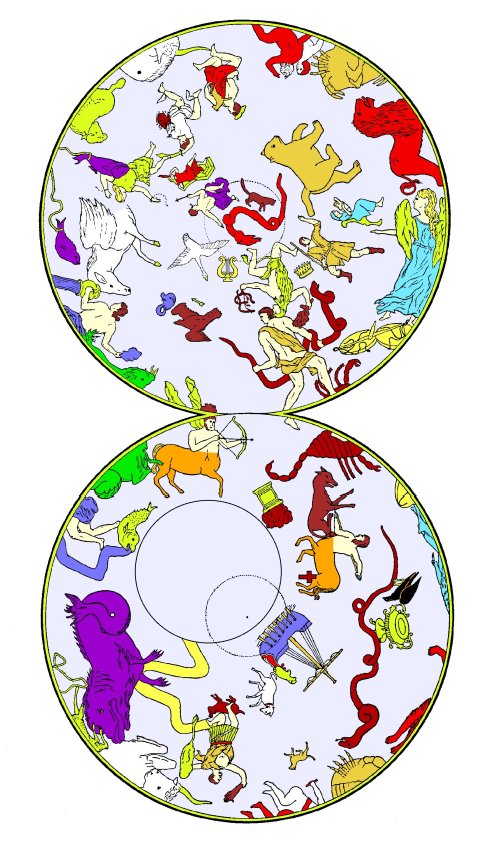 |
Now for the logical extension of this concept. Even as the Savior referred to the general locations of heaven and hell, so also do the stars. All of the constellations above (north of) the zodiac represent heaven, and all of the constellations below (south of) the zodiac represent the underworld. Thus, in Figure 3, “heaven” is the upper hemisphere of sky north of the zodiac constellations, and “hell” is the underworld of constellations shown in the bottom circle. Notice that the upper circle contains many flying creatures such a Swan, Eagle, Flying Horse, an Arrow, and even a Dolphin which jumps out of the sea and “flies.” On the other hand (left hand), the lower circle is filled with things below the earth, often represented by the sea, such as the Sea Monster, Water Serpent, River, Ship, etc.
The highest level of heaven, the celestial kingdom, is represented by the constellations nearest the center of the upper circle (the north ecliptic pole), the terrestrial by those near the middle, and the telestial by those nearest the zodiac figures. Similarly in the lower circle, paradise is represented by the figures just below the zodiac, whereas those nearest the center of the circle such as the Centaur and the Cross represent perdition. Now let us look at the roles of the seven angels in each of these areas at different times.
2. Seven Angels
Before we begin, it might be well to review the seven players in this drama. In an earlier article the seven chief angels of God were identified, along with some of their principal roles.[3] Here is a brief review of the order in which each will sound the trump to open the Millennium.
1. Peter and the Celestial Kingdom. First is the trump to announce those who resurrect to the highest heaven, the celestial kingdom, where God the Father dwells (D&C 88:94-98; 76:50 70). It was proposed that the first angel is Uriel, known in mortality as Peter, whose principal assignment is to preside over those valiant Christians who qualify for that highest heaven.
2. Moses and the Terrestrial Kingdom. The second trump is for the terrestrial kingdom, the second highest heaven, which is prepared for the honorable people of the earth who chose not to accept and live all of the teaching of Jesus Christ. It was proposed that the second angel is Raguel, known as Moses in his mortal probation, who has been like a shepherd to his people both in life and afterward, to prepare them to receive Christ either at his first or second coming.
3. Abel and the Telestial Kingdom. The third trump is for the telestial kingdom, designed for those who rejected the word of God, but who someday will bow the knee to Jesus. After death they suffer torment, and have to remain in hell until after the Millennium (D&C 88:100-101; 76:81-90, 98-112). Those in this kingdom do not enjoy the presence of either God the Father nor Jesus Christ, but are presided over by the Holy Ghost and ministering angels (D&C 88:86-88). It was proposed that the third angel is Sariel, known in life as Abel, and that one of his key roles is to preside over hell, and attempt to help its inhabitants repent and qualify for the highest kingdom possible. Abel was the first martyr and the first to enter the spirit world. In the Greek myths it is Hades who presides over the underworld, so Hades can be identified with Abel. After hell shuts down at the end of the Millennium, presumably Abel will continue to lead his “graduating class” in the telestial kingdom.
4. Enoch and Sons of Perdition. The fourth trump is for those who not only reject Jesus Christ, but also the Holy Spirit after having received it. Even after all of Satan’s deceitfulness is exposed during the Millennium and those who mistakenly served Satan repent and turn to Christ, these will still willingly serve Satan by choice (D&C 76:25-38, 43-49). It was proposed that this fourth angel is Raphael, known in life as Enoch. He was translated to heaven (celestial kingdom) with his whole city. When some of those angels fell to the enticing of Satan, even after all that they knew, they became sons of perdition. Thus Enoch presided over a righteous city on earth (Moses 7:19-21), over his followers in the highest heaven, and also over the lowest of the low. But after the final Judgment Day at the end of the Millennium, Enoch’s charge over them might end when they are cast out into the lake of fire with Satan (Rev. 20:10-15). Moreover, Enoch was known as “the scribe” and it is proposed that he acted as a secretary to the Presidency of Peter, Moses and Abel. As has been discussed, each of those four members presided over a different level of spirituality, and the areas of heaven and hell where such people reside. But it was proposed that Enoch served a double role, also being secretary to the following presidency.
5. Joseph Smith, Second Counselor. It was proposed that the Prophet Joseph Smith is the fifth angel, Phanuel, and that he functions as a second counselor in a presidency over all of the above individuals, but arranged into different groups. He is the counselor assigned to Zion, being the western hemisphere. He also has the special assignments of ushering in the Dispensation of the Fulness of Times, when all of the other six angels returned and gave him their keys and gifts so that the fulness of the Gospel would be restored on earth in preparation for the Second Coming of Jesus Christ. He also has the special assignment of the salvation of mankind, both the living and the dead, in a role similar to Jesus Christ in the First Presidency of Heaven of the Father, the Son and the Holy Ghost. He was even sacrificed as a lamb, as was the Savior.
6. Noah, First Counselor. It was proposed that Noah is the sixth angel, Gabriel, and that he also functions as the first counselor in the First Presidency of the Earth. He is assigned to the eastern hemisphere, where his ark landed after the great flood. He is also assigned to spiritual roles, comparable to the Holy Ghost in the Godhead. He presides over the restoration of the gospel (as Elias/Gabriel, D&C 27:6-7), likely including the pouring out of knowledge and blessings on the heads of the saints (D&C 110:9, 121:33).
7. Adam, President. The scriptures explicitly tell us that the seventh angel is the archangel Michael who will lead the armies of God to overcome Satan in the great war at the end of the Millennium when Satan is finally defeated forever (D&C 88:110-115). Michael was known during mortality as Adam (D&C 27:11), the father of our human family. It was proposed that he presides over all of the earth and all of mankind. Adam’s duties almost all pertain to the earth, rather than heaven or hell.
3. The Table of 49 Constellations
Figures 1 and 3 illustrate the basic set of 48 constellations preserved by the ancient astronomers and attributed to the prophet Enoch. Let us now consider the possibility of adding one more constellation which is one of the most heralded asterisms in the heavens.
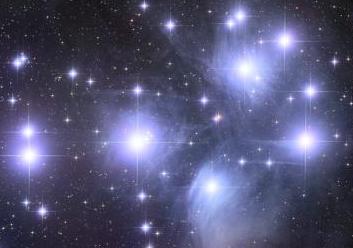 |
3.1 The Seven Sisters
When one attempts to define exactly what constitutes the list of 48 constellations, the Seven Sisters (Pleiades) are always a serious contender to be called a separate constellation by themselves. They are really a small cluster of nearby stars which are individually visible on the back of the Bull. In Figure 3 they are shown as the black spot on the upper back of the Bull. There is an amazing amount of detailed myth about each of these seven daughters of Atlas, much more than about many of the larger constellations.[4] But the group is so small as not to form any real figure, and so they are usually considered as part of the constellation of the Bull. The Greek name Pleiades is thought by some to derive from the similar Greek word for “doves” and they are sometimes considered to be a flock of seven doves riding the bull (Peleiades means “flock of doves”).[5] For the purposes of this article, let us consider counting the Seven Sisters (or Doves) as a forty-ninth constellation.
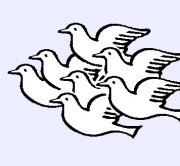 |
3.2 Mapping the Heavens
Let us now construct a map of the heavens. Let us take the constellations shown in Figure 3, and lay them out on a flat square projection by cutting the sky into 49 pieces arranged in 7 rows and 7 columns. The seven rows are three rows up in the heavens (in the upper circle of Figure 3), one row for the zodiac circle (split between the upper and lower circles), and the three rows in the underworld (lower circle). Thus, the top row is composed of the constellations nearest to the center of the upper circle, the second row of constellations below them, and the third row of ones nearest the zodiac. The fourth row contains seven of the zodiac constellations, with the lowest five of them on the fifth row. The last row contains the constellations which border on the empty circle in the south. Thus, the seven columns correspond to areas of the zodiac and the seven rows are the division of the heavens, the earth and the underworld. The top row is the highest heaven and the bottom row is perdition.
Figure 4 illustrates the resultant map. Some of the constellations need to be moved slightly to fit the pattern but to me it was amazing that it was possible to do at all. There were just enough constellations to make exactly three rows of seven above the zodiac, and also 21 in the lower regions. Those at the top of the table are in the northern sky and those in the bottom are in the south (as seen from the northern latitudes). When one faces south and sees those on the right in the west, then those to the left of them will be east of them.
To make the arrangement even more clear, look at the constellations nearest the center of the top circle in Figure 3. They are the Dragon at the very center, surrounded by the Little Bear, the King, the Swan, the Harp, and Hercules. That is only six and seven are needed. Possible candidates are the Flying Horse, the Arrow, the Crown, and the Queen, which are all about equally close to the center. Here an ancient tradition helps us, where we are told that Pegasus “beats his swift wings in the topmost circle of the sky.”[6]. When all of the constellations are accounted for, it turns out that Hercules drops out of the top circle to be below the Dragon and the Crown is promoted to the top circle, being at the top of its column of constellations. Thus, the highest circle of the heavens is occupied by the Dragon, Little Bear, King, Swan, Flying Horse, Harp, and Crown. Continuing that manner of placement allows the entire table to be completed. One other adjustment was that it became clear that the Serpent Bearer and Serpent should be combined into one constellation because together they represent one angel, and the Twins (Castor and Pollux) should be separated because they represent two. The important thing is that the table is actually a map of the heavens, rather than being simply an arrangement designed just to reach the conclusions of this article.[7]
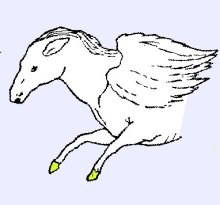 |
3.3 Perfect Pictures
Before proceeding, note the appropriateness of each of the figures in representing something from that kingdom. In this symbolism, beauty symbolizes righteousness, whereas the wicked are ugly. For example, the swan is one of the most beautiful birds and the horse is a beautiful animal. The harp creates some of the most peaceful, soothing music. Kings and crowns are associated with heaven. Thus, it is totally appropriate to have those emblems as symbols of heavenly beings. The Little Bear is not as obviously beautiful and the Dragon seems totally out of place here, and apparently represents Satan attempting to usurp the throne of God at the very top of the heavens. Similarly, the ugly monsters fill the very bottom row, especially the Sea Monster and Hydra. The Cross, a horrible instrument of torture is there, and the River of judgment of the wicked, and the promiscuous Hare, representing the wicked harlot. The next row up represents hell and contains the Bands which shackle the righteous to the Sea Monster (death and hell), the Cup of the wrath of God, and the Altar of the fires of hell.
4. One Column Per Angel
Now that we have seen that the rows represent different degrees of heaven, earth and the underworld, let us consider the seven columns. It is proposed here that each of the seven columns represents the deeds of one of the seven angels. Figure 4 shows the angels’ names above each column and the physical locations at the head of each row. Thus, any given square represents one angel being at a certain place. For example, the Swan represents Peter in the celestial kingdom. Note that there is no time line shown in this arrangement. The angel could have been there early or late in history, but the implication is that each of the angels had something to do at some point in time with each of the places or with a being from that place.
4.1 The Bright Stars
As Enoch was told by the angel Uriel, the bright stars represent the righteous servants of God (Enoch 43:1-2). Note that there are almost no bright stars in the constellations which represent evil: The Dragon, Sea Monster, Hydra, Crab, River, Hare are dim indeed. The only exception is that the Cross has two of brightest stars in the sky. To me, even that is not an exception, because it reminds us that Christ died on the cross, and the bright stars are really in the figure of Christ, where the nails pierced his hands and feet. If we had the original figure, we might find it showed the Great Sacrifice of the Redeemer nailed to the cross, so that the bright stars would be in the Savior. If so, then all of the bright stars would represent the righteous.
One thing that put me onto the significance of this arrangement, is that the bright stars in the sky mostly happen to fall where the angel performed his most important work. For example, Peter’s main calling appears to be to preside over the celestial kingdom and the only bright star found in his column is Deneb, in the Swan, in the highest heaven. The only other bright star in the highest heaven is Vega in the Harp. That is in Enoch’s column, and reminds us that he and his entire city were translated to heaven. If that coincidence is due to blind chance then we must ask what is the probability that the only two bright stars in the highest heaven would fall into the columns of Peter and Enoch? Before calculating that, let us first look at all of the other perfect positions.
The brightest stars in the sky which fall into these constellations are shown in Table 1. Just from what has been reviewed above of the duties of the seven angels, we see that each of the first four angels who preside over a level of spirituality has a bright star in their area: Peter in the celestial kingdom (Deneb in the Swan), Moses in the terrestrial (Arcturus in the Herdsman), Abel in the telestial (Capella in the Charioteer or Goatherd), and Enoch presides over the sons of perdition (Rigel Kentaurus in the Centaur). Moreover, Enoch also presides over his city in heaven (Vega in the Harp) and Abel presides in Hell (Procyon in the Little Dog). Of course, we have already covered the presidency of the earth with the bright stars for Adam (Regulus in the Lion), Noah (Fomalhaut in both Waterman and Southern Fish), Joseph Smith (Aldebaran in the Bull) and Enoch (Antares in the Scorpion and the Healer), all in the middle row. Thus those four cornerstone stars are part of this same expanded pattern that covers the entire sky.
| Moses | Enoch | Noah | Peter | Joseph | Abel | Adam | |
|---|---|---|---|---|---|---|---|
| Celestial | Vega | Deneb | |||||
| Terrestrial | Arcturus | Altair | |||||
| Telestial | Antares | Capella | |||||
| Earth | Spica | Antares | Fomalhaut | Aldebaran | Castor | Regulus | |
| Paradise | Fomalhaut | Pollux | Rigel | ||||
| Hell | Sirius | Procyon | |||||
| Perdition | Acrux | Rigil Kentaurus | Canopus |
I will not attempt to calculate the odds of each of these bright stars just happening to fall into the correct squares where those seven angels did their most important work, but they are clearly astronomical. It was seeing these stars all fall into place that convinced me to research further what could be deduced about the duties of each of these angels.
4.2 Noah Presides in Paradise?
Indeed, we can propose some possibilities right now. Who presides in paradise? Abel would have been the first one to arrive there, and would have presided until the arrival of Adam. But we see no bright star for Adam in the Paradise row. The next of the angels to arrive would have been Noah and there we find the bright star Fomalhaut located in the head of the Southern Fish. Now we see the symbolism of what that fish represents. The fish is the symbol of the Christian faith and now we see it is located in paradise. Long ago we identified Fomalhaut as being the star of Noah, and now we see that his star is located as the head of the church in paradise. The combination of the star being in the head, of being in the fish, and being located in paradise is enough for me to propose that one of Noah’s duties may well be to preside in paradise.
5. Seven Roles Portrayed
Let us now consider the symbolism of each column in detail, to see what might be implied about the deeds of that angel. Let us proceed from west to east, beginning with Moses and ending with Adam, in order to go through the zodiac in order.
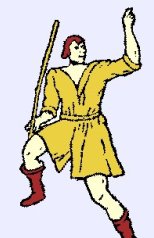 |
5.1 Moses
The first column (on the far right in Figure 4) is indicated to be that of Moses because all seven figures relate to incidents in his life. As an infant, he was raised by a queen (Infant Prince). According to the Book of Jasher, he became the king of Ethiopia (Crown) and then a shepherd (Herdsman). In fact, his principal role has been to prepare his flock to accept Christ at either the First or Second Coming. He has been like a mother hen to them (Maiden). He had a healing experience with the serpent on the cross, symbolizing the crucifixion of Christ (Cross). He was known as the Lawgiver and he was a Judge of his people, and attempted to atone for their sins (Balance) (Ex. 32:30). And the burnt offerings of the law of Moses, often to purge from sin, are also shown (Altar).
Think about the chance of all seven of these figures being perfect hits for Moses. Which other angel was raised by a queen as an infant? Who else was a shepherd? Who else had an experience with a cross? It was astounding as this pattern unfolded before me that it was possible to have all of this significance using a table which is a simple map of the heavens.
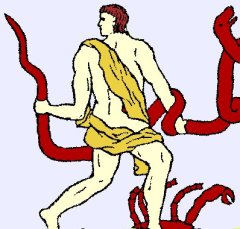 |
5.2 Enoch
Now let us turn to Enoch. We have reviewed in earlier articles that Enoch was associated with the Healer. In the myths he is represented by Hermes (Mercury), the swift moving messenger of the Gods, the father of medicine and inventer of the harp. Another messenger of Zeus was the Eagle, which constellation also falls into Enoch’s column. His entire city was translated to become a city of angels in heaven (Harp). Its inhabitants there had not finished their mortal probation, and some of those who looked to him for guidance fell to the bottom depths of perdition, where there was no forgiveness for them. As discussed above, it is proposed that Enoch is the fourth angel who still presides over that group, trying to get them to qualify for at least a telestial glory before the final judgment. In the stars, he is represented in perdition as the Centaur, an appropriate figure to represent someone who is part time presiding in the celestial realm and part time in perdition. The myths about the Centaur, Chiron, also explain that he was a healer. Thus, it is no surprise to find the Archer, who is also a centaur, in Enoch’s column in the Paradise row. There may well be a great story of his work as the “Archer of Paradise” which is not familiar to us.[8] The Beast may well represent the same adversary as the Scorpion, both being overcome by Enoch as the Healer and the Centaur, respectively, but the precise significance in the life of Enoch is not clear yet.
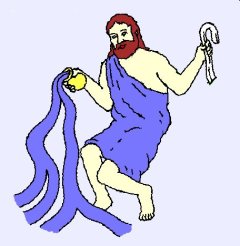 |
5.3 Noah
Noah is always associated with water, and some of the myths about Poseidon suggest that he symbolizes Noah. This is a watery column indeed with the River, Southern Fish, Sea Goat, Waterman, and Dolphin all in it. Thus we see that the water animals are not only more populous in the sea (south), but also in this one column of sky, extending even into the heavens. Even the Flying Horse fits, because Poseidon, god of the sea (Noah) was said to have created the horse to be the most beautiful animal. Only the symbolism of the Arrow is not clear. As for the Flying Horse (Pegasus), it comes in the last days, and may represent Noah in his role as presiding over the entire restoration of the Gospel. Pegasus was born of the blood of the slain Medusa, who was beheaded by Perseus. As mentioned above, it is proposed that Noah presides over the church in paradise, represented by his star Fomalhaut being the head of the Southern Fish. Thus, these symbols fit well with Noah’s life and deeds.
5.4 Peter
Peter’s calling in life and eternity has been to preside over the Christian church in the celestial kingdom. His only bright star is in that row, suggesting that his role is focused there. Let us now turn to the shackled Fishes to recall the history of his persecution and death.
Jesus prophesied of the death of Peter:
He saith unto him the third time, Simon, son of Jonas, lovest thou me? Peter was grieved because he said unto him the third time, Lovest thou me? And he said unto him, Lord, thou knowest all things; thou knowest that I love thee. Jesus saith unto him, Feed my sheep.
Verily, verily, I say unto thee, When thou wast young, thou girdedst thyself, and walkedst whither thou wouldest: but when thou shalt be old, thou shalt stretch forth thy hands, and another shall gird thee, and carry thee whither thou wouldest not.
This spake he, signifying by what death he should glorify God. And when he had spoken this, he saith unto him, Follow me. (John 21:17-19)
How was this prophecy of Peter’s death fulfilled? When did he stretch forth his hands, when was he girded by another, and carried where he did not want to go? Allow me to quote an excellent detailed account of Peter’s martyrdom.
“Maliciously condemned, Peter was cast into the horrible, fetid prison of the Mamertine. There, for nine months, in absolute darkness, he endured monstrous torture manacled to a post. Never before or since has there been a dungeon of equal horror. . . . The Mamertine is described as a deep cell cut out of solid rock at the foot of the capitol, consisting of two chambers, one above the other. The only entrance is through an aperture in the ceiling. The lower chamber was the death cell. Light never entered it and it was never cleaned. The awful stench and filth generated a poison fatal to the inmates of the dungeon, the most awful ever known. . . . How Peter managed to survive those nine long dreadful months is beyond human imagination. During his entire incarceration he was manacled in an upright position, chained to the column, unable to lay down to rest. . . .
“Peter, the Rock, as he predicted, met his death at Rome by the hands of the murderous Romans, who crucified him, according to their fiendish manner. He refused to die in the same position as our Lord, declaring he was unworthy. Peter demanded to be crucified in the reverse position, with his head hanging downward. Ironically enough, this wish was gratified by the taunting Romans in Nero’s circus A.D. 67”[9]
Peter was an astounding example for all of us. It was said that during his suffering he was always praising God, and that 47 of his guards were converted during those nine months. The purpose of the two chambers was to keep the lower chamber in total darkness all the time, even when he was being given his meager rations. Most men imprisoned there went mad and died in a few weeks, so it is indeed amazing that Peter could survive so long and so well.
To me the Savior’s prophesy has a double meaning. Peter’s outstretched hands were girded (manacled) and he was taken to the Mamertine prison, where he did not want to go. Then again his outstretched hands were girded (nailed) to a cross. Truly the precise manner of his death was foreseen by the Savior. But how far ahead of time was it foreseen?
Getting back to the constellation symbolism we see the Chained Princess, representing the Christian church, and also Peter as its leader, manacled with arms outstretched. And we see the fishes also shackled by the Bands to the Sea Monster from perdition.
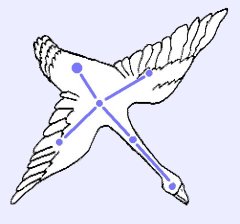 |
In the section on Moses above, the question was raised of what other angel had an experience with a cross. Well Peter certainly did! And it turns out that there are indeed two crosses in the heavens. The constellation of the Cross is usually called the Southern Cross because another name for the Swan is the Northern Cross. Note how the stars in the Swan form a nearly perfect crucifix in the heavens. And also note that the Swan is upside-down on the cross, the head of the Swan being the foot of the cross. Could it be that Peter’s upside-down crucifixion could have been represented in these heavenly figures thousands of years before it occurred? What do you think?
There is no doubt in my mind that the answer is yes, because the symbolism is too clear and too perfect. The Swan is Peter’s principal constellation because it is in the celestial kingdom row, the place of his calling. I have taught astronomy students for thirty years that the head of the Swan is at the foot of the Northern Cross with no thought that there was any connection. Now that my eyes have been opened to see the deeper meaning as this article was being written, that constellation will never be the same.
The Queen, another symbol of the Church, also fits well in this column also, so this column gets a score of seven out of seven meaningful figures.
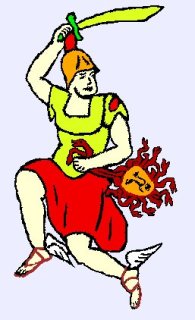 |
5.5 Joseph Smith
Finally we come to one of the seven angels whose history we know. Or do we? Actually, we mostly know facts only about his short mortal life and this chart is about deeds in many places. Joseph Smith was identified in an earlier article as represented by the star Aldebaran, at the eye of the great white Bull, representing his role as seer (eye) and head of the Kingdom of God preceding the Millennium. Now let us turn to the other symbols.
The Seven Sisters represent all seven of the angels. Why should that constellation fall in the column of Joseph? Is it not because all seven are part of his story? The other six (and only six are visible) all came to visit him and bestow their authority and priesthood keys upon him. Joseph presides over the dispensation of the Fulness of Times, when all things come together, and to me that is part of the symbolism of the Seven Doves. The dove also symbolizes the Holy Ghost, who presides over the telestial kingdom, along with ministering angels. Note that this constellation is found on the level of that kingdom, hence seven doves seems like ideal symbolism for those ministering angels in that role.
Perseus Myth. The best known myth to astronomers is that of Perseus because it involves seven constellations in the late summer sky. The myth has been on my website for years for my beginning astronomy class to memorize to tell around the campfire.[10] That constellation of the Hero (Perseus) falls into the column of Joseph Smith, so let’s review part of it to see if it might relate to his life in some way.
Perseus became obligated to obtain the head of the horrible Medusa, who had snakes for hair, and her face so ugly it turned any onlooker to stone. As he began his quest, he went to a sacred grove, where he was told that the gods would help him. Soon he met a messenger of the gods who gave him a hardened sword which could not be broken by Medusa’s scales. It had been made by Hephaestus, the blacksmith god who worked underground. Then Athena appeared and gave him her polished brass breastplate, which he could use both as a shield and also as a mirror in which to look at the abominable Medusa indirectly, to avoid being immobilized. The messenger, who carried a winged staff, also unfolded a plan to obtain three more gifts he needed, which Perseus executed as follows.
First he had to go across the great ocean to Mount Atlas and snatch the one eye shared by three seeresses known as the Gray sisters, who looked like swans. He did so and refused to return it until they told him the location of the Nymphs of the North. It was said that their land beyond the North Wind was not reachable by land nor sea. After learning of their hidden location, Hermes took him there, where he received a) winged sandals enabling him to fly, b) a magic silver pouch to safely carry the Medusa’s head, and c) a helmet of invisibility made by Hades in the underworld. Thus equipped, he successfully slew the Medusa and returned with her head in the pouch. There is much more to the story, including saving the Chained Princess from the Sea Monster, but this is sufficient for our purposes.
Does all of this have anything to do with the Prophet Joseph Smith? For starters, his experience also began in a sacred grove, where he learned that he would be an “annoyer” to the powers of darkness (JSH 1:19-20). Then a messenger from God appeared to him and provided him with two sacred gifts. One was the double-edged sword of the word of God (Eph. 6:16-17, Heb. 4:12, D&C 6:2), written on golden plates by the dead in the underworld. The other was an actual brass breastplate (D&C 17:1), “such as was used by the ancients to defend the chest,”[11] with two stones in silver bows attached to it called the urim and thummim, into which he could look to see things (JSH 1:34-35, 59; D&C 17:1). The fact that both of these gifts match so precisely in detail what Perseus was given clearly points to Joseph Smith as being Perseus. If so, we might want to ponder the implication that these details about a vision in a sacred grove, and the gift of a breastplate of armor used not for shielding blows but rather for seeing, were known thousands of years ahead of the event and important enough to be “written in the stars.”
Moreover, there was also an ancient physical sword of fine steel associated with these two gifts called the sword of Laban, but it is not clear that Joseph was actually ever given that sword. It seems rather to have been a physical symbol of the spiritual sword of the word of God which Joseph would wield.[12]
The high priest of Moses also had a urim and thummim attached to his breastplate of judgment (Exo. 28:30, Lev. 8:8). Here we might note that Athena was the virgin goddess who is sometimes shown holding the balance of justice. The two zodiac signs in the column of Moses are the virgin Maiden and the Balance. Thus, Moses can be identified with Athena, and the breastplate with urim and thummim similar to that of the high priest. The Medusa had been a beautiful maiden until committing fornication in the temple of Athena (temple of Moses), after which Athena turned her into a monster. As we shall see below, the Medusa might tie to the wicked harlot who has prostituted her religion.
Joseph Smith was then given a series of priesthood powers and keys from all of the other six angels. One of the first of these was from Peter (accompanied by his counselors James and John). We have seen that the seer Peter has the Swan for his constellation, so the three “swan women” whom Perseus visited relate directly to the three swan seers of Peter, James, and John. Moreover, Joseph Smith remarked that John was working with the lost tribes of Israel,[13] so John would be ideal to reveal their location beyond the North Wind.
One pertinent detail is that Perseus had to go across the great ocean in order to talk to the Gray sisters, who guarded Mt. Atlas. Where was Mt. Atlas? That has puzzled scholars, who think Mt. Atlas is in Africa, across the Mediterranean Sea from Greece. A big clue is that the Garden of Hera with the golden apples guarded by the dragon was at the foot of Mt. Atlas. That garden clearly represents the Garden of Eden. Isn’t it interesting that Joseph Smith identified Missouri as the land where the Garden of Eden had been, and also the location of the Mt. Zion spoken of in scripture and the future city of Zion (D&C 57:2, 76:66, 84:2). Joseph was required to go to Zion, even as Perseus was required to go all the way across the (Atlantic) Ocean to Mt. Atlas. To me that is an amazingly accurate detail to have been included in the saga. But maybe it should not be so surprising because Enoch, founder of the city of Zion, most likely wrote the myth.
If Perseus really is Joseph Smith, then what was the helmet of invisibility that Joseph received from Hades (Abel), lord of the dead? Perhaps the helmet was death itself, for perhaps only as an invisible spirit could Joseph decapitate the Medusa, and finish the work he began in mortality. Similarly, the winged sandals which he was given to rapidly fly where he wished fit perfectly with the ability of a spirit to travel almost instantly to a desired destination. As for the silver pouch, no clear interpretation is immediately apparent. There is much more left to be understood about the Perseus myth, but there is no doubt to which of the seven angels it refers.
The Big Dog and Hare. A second witness that this interpretation is correct is that both the Big Dog and Hare are also in Joseph’s column. The dog is a greyhound in pursuit of the wicked, promiscuous hare. That sounds very similar to the quest of Perseus for the death of the Medusa. Thus, it appears that one of the special callings of Joseph Smith, as both Perseus and the Big Dog, is to help destroy the prostituted religion and/or secret combinations, which had caused him much grief during mortality.
The other constellations in Joseph’s column are the King and the Champion (one of the Twins). Although Joseph was Mayor of Nauvoo, and running for the U.S. Presidency when he was martyred, the King more likely refers to a role of his in the celestial kingdom, where the sign is found. Let us now turn to his role as Champion in the discussion of the other twin, the Warrior, in the next column.
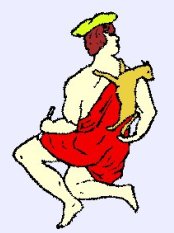 |
5.6 Abel
Abel apparently has two main assignments from what we have been able to deduce. First he presides over the spirits in hell, and then when those who had been deceived have suffered sufficiently, repent and prove that they do not wish to continue following Satan, then Abel continues to preside over much of the same group when they resurrect to the telestial kingdom. The constellation of the Little Dog apparently is identical with the Egyptian god Anubis, the jackal who was the guide to the underworld (Abel). The Charioteer is in the row of the telestial kingdom, and he is holding three goats in his arms, a nanny and two kids. It has been argued that the Charioteer could also be called the Goatherd because that is how the figure is depicted. Isn’t it interesting that he is caring for goats, the symbol of the rebellious, who suffer in hell. Thus, the goats being found in the telestial row fit perfectly with Abel being their Goatherd.
Another of the constellations in Abel’s column is the Ship, named Argo in mythology, which carried many on a successful quest to obtain the golden fleece. It was led by Jason, who again seems to be Abel, and the quest was seeking the golden fleece of the Ram (eternal life). Both the Little Bear and Big Bear are in this column, and they probably represent other flocks, one being in the terrestial kingdom row, and one in the celestial kingdom. The Persians show these three constellations as three women, one of the symbols for the church. Did Abel have responsibilities for three flocks? Do the three goats also represent these flocks?
To me, the answer must be affirmative, with one of those flocks headed for each of the celestial, terrestrial, and telestial kingdoms. It is my understanding that even those who have been wicked in mortality and are consigned to hell, if they repent in time (before the Second Coming), they can still inherit the celestial kingdom. If so, then Abel was indeed presiding over three levels of spirituality represented by the two bears and the ship. Note that the sizes of these constellations is probably important. The smallest group is the Little Bear, the next larger is the Big Bear, and the huge constellation is the Ship. Those sizes could well represent the relative number who finally inherit each kingdom. Similarly, as the Goatherd, he is caring for three goats, a large one and two kids. Again, the large one would represent the biggest group of telestial beings.
The Twins. In this context, the Twins are two separate constellations. In the sky, one is clearly above the other, and in the table of 49, the one in Abel’s column, the Warrior, is on earth, while the one in Joseph’s column is in Paradise. In mythology, the Twins are Castor and Pollux, and there are bright stars with those names at the head of each twin. Castor was a warrior, being an expert swordsman, and Pollux was a champion boxer, so I have chosen the names Warrior and Champion for English translations of their symbolism.[14]
Who are these twins? Are they not the same as the Big Dog and the Little Dog, also found in those two columns? Castor represents Abel, and Pollux represents Joseph Smith. As for the boxing, to me it was clearly originally “wrestling,” but has been mistranslated somewhere along the long line. Joseph Smith was famous for his championship wrestling ability, and was able to throw other expert wrestlers.[15] He even defeated a bully in order to raise money to free his friend Porter Rockwell from prison.[16] It would be hard to write a biography of Joseph Smith without mentioning that he was a champion wrestler, and apparently even the biography in the sky depicts this prowess. Thus, the Twins could probably also be called the Wrestler and the Swordsman.
The mythology here seems revealing. The twins were both aboard the ship Argo and between them they saved its passengers on a few occasions. The world’s greatest bully would not allow the Argonauts to leave until one of them had fought him. Pollux accepted his challenge, side-stepped his advances, and won the contest. Thus, Pollux was a champion in both senses of the word: he was the best at his sport, and he used that skill to champion the cause of his shipmates and help save them. Note also how much the fight of Pollux correlates to Joseph Smith, who threw a bully to save someone in prison. Thus, the Twins became the patron saints and saviors of shipwrecked sailors. Poseidon, the god of the sea, gave them both white horses to ride.
But there is more to their story. Castor was slain first and Pollux mourned for him and avenged his death. Later, when Pollux was awarded immortality in heaven, but Castor was not, Pollux refused to accept it without his brother. Therefore Zeus allowed them to take turns, with one being in heaven while the other was in the underworld. What is all that about? Again, let us think about who has what assignment. If Abel (Castor) presides over hell until the end of the Millennium, then he would not be allowed to go to heaven with his brother Joseph at the beginning of that era. It sounds to me like the love of Joseph for his spiritual twin Abel is so great that perhaps it has been worked out that they will alternate presiding in hell during the Millennium. If so, then Castor and Pollux should indeed both be the patron saints of the sailors on board the Argo.[17] Another point here is that sailors would sacrifice a white lamb to bring their help, and the white lamb is indeed symbolic of both Abel and Joseph who were each sacrificed as a pure and innocent lamb.[18]
The other constellation in Abel’s column is the brightest of all, being the Hunter (Orion). Both of the Dogs are apparently the Hunter’s dogs, so in that context, the Hunter is definitely part of Abel’s story, for the Little Dog serves its master. But who is the Hunter? In last month’s article we noticed that the Hunter is depicted holding the lion’s skin, wearing a belt of pearls, and wielding a club, all of which are indications of Hercules. Now we see that Hercules and the Hunter are one and the same person in this context, namely Adam. Adam is definitely part of the story of Abel, being his father. But Adam is also the father of the entire human family, and he is the archangel whom all of the other angels serve. Adam is the Hunter King who is seeking to destroy the Hare, but who delegates much of the job to his twin sons, Abel and Joseph Smith. Let us now turn to the deeds which capture the focus of the great one.
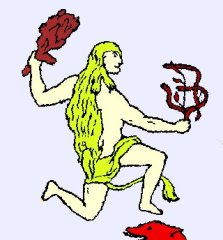 |
5.7 Adam
The last angel is Adam, the archangel, the greatest and father of all. The last zodiac constellation is the Lion, which we have seen represents Adam, with the bright star Regulus at its heart. In this column we find that every constellation refers to the myth of Hercules, the greatest of all of the sons of Zeus. Let us see in the myth of Hercules if there are any true traditions preserved about Adam.
Hercules actions caused the deaths of all of his children, for which he was afterward remorseful. Is that not symbolic of the fall of Adam, who indirectly caused the death of all of his posterity? To pay penitence, Hercules had to perform twelve great labors, but let us focus only on those shown in the stars. Hercules triumphed over the Dragon which guarded the golden apples in the garden of Hera. That clearly alludes to the fruit of the Garden of Eden, “guarded” by the serpent, who was really the Dragon Satan in disguise. The scriptures tell us that Michael (Adam) is the angel who ultimately defeats the dragon, the “old serpent, called the Devil, and Satan” (Rev. 12:7-9). We see Hercules defeating the Dragon in the heavens, where his foot is squarely on the head of the Dragon in the center of Figure 3. Thus, the identification of Hercules with Adam seems clear. Hercules was the greatest hero, and Michael is the archangel. Besides, which other angel caused the death of all of his children?
Hercules’ first labor was to kill the Nemean lion (the Lion). That lion’s hide was impervious to any weapon, so he strangled it. He then made a garment for himself from its pelt to be a shield and a protection, and used its gaping mouth as a helmet. Note in the constellation figure, Hercules is shown wearing the lion skin garment. Then Hercules had to destroy the many headed monster Hydra, a giant Water Serpent who dwelt in a swamp. When he cut off one head, two would grow in its place. While fighting the Hydra he was also attacked by the Crab. He stomped on the Crab with his foot and called for the help of his Charioteer, who burned the stumps as each head was lopped off, which prevented new ones from growing. We see in his column of the heavens both the Crab and Hydra, found in the telestial kingdom and perdition rows. We also now recognize the Charioteer (or Goatherd), identified as Adam’s son Abel, would be ideal to help his father.
Who do the Hydra and Crab represent? Are they not the same as the seven-headed monster in Revelation, and his helper, the second beast who enticed all to worship the first beast (Rev. 12:1-12). Both of these two, the beast and his false prophet, were finally overcome and were cast alive into the lake of fire and brimstone at the beginning of the Millennium (Rev. 12:20). Then finally, after the Millennium, the Dragon is also cast into the same lake where both the beast and the false prophet are (Rev. 20:10). Thus we see the Dragon, the seven-headed monster from the sea (Hydra), and the false prophet (Crab) are three distinct entities, and each is represented by a separate constellation in Adam’s column. Note also that two of these constellations are out of place. The Dragon is pretending to be God, sitting on the throne at the top of the sky. Similarly, the Crab is also located in the lowest heaven, pretending to be a prophet of God. As a symbol of Christ the Crab represented the Deliverer; it would not be surprising if the false prophet also promised to deliver the downtrodden from oppression. Indeed, he is the prophet of the Dragon, an anti-Christ, a beast that appears as a lamb (Christ) but who speaks as a Dragon (Rev. 13:11).
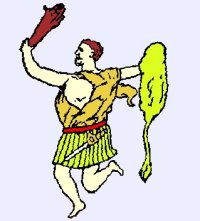 |
One of the twelve labors of Hercules was to obtain the belt of the Queen of the Amazons, the warrior women who despised marriage and destroyed their men (sound like anyone you know?). He succeeded, and when they retaliated against him, he and his helpers destroyed them. The Hunter wears that belt of pearls, displayed in the heavens as the magnificent Belt of Orion,[19] and he also holds the lion skin, which identifies the Hunter as Adam. Hercules also had to disperse a flock of marauding birds with arrow-like feathers, and a fire-breathing bull. We find the Raven in his column and the Bull nearby. And he diverted a River, which is shown in front of the Hunter. In last month’s article the meaning of the River was not clear, but with the Hunter being identified as Adam, the Ancient of Days (D&C 27:11, 116:1, 138:38), the River now indeed appears to be the river of fire that proceeds forth in front of him at a time of judgment (Dan. 7:9-13). Hence the River is yellow in the illustration, representing the fires of perdition. It is supposed to encircle the southern ecliptic pole (the lowest point of perdition), even as the Dragon encircles the highest point.
What is the symbolism of the Raven? That sign is found in the paradise row. To me it represents any of the dead who are in the spirit prison. We saw in an earlier article that Noah’s raven, who went “to and fro in the earth” was identified with Satan who did likewise (Job 1:7).[20] But, being in paradise suggests that the Raven can also represent the righteous dead. The Raven is shown attacking the Hydra, implying that he is on the righteous side of that battle. And what of the Cup which also is shown on the back of the Hydra? As it last month’s article, it could represent both the Cup of the wrath of God poured out on the Hydra, and also the harlot (Hare) who rides the back of that monster.
Thus, Hercules is not only identified as Adam, but also is the Hunter (Orion), the brightest constellation of the sky. He has two principal helpers in his hunt for the wicked Hare, being the Big Dog (Joseph) and the Little Dog (Abel). Note that both Abel and Joseph were slain by secret combinations (the Hare), so it is not surprising they both seek to destroy her. Thus the ancient myths seem to tell us much about the work of these chief angels.
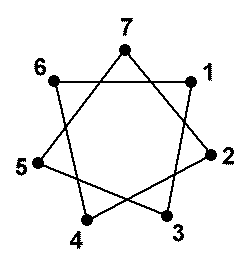 |
5.8 Twins Reversed
God’s house is a house of order, and it is fair to ask in what order are the columns of the seven angels found. According to the numbers assigned to them for the order in which they sound the trump, noted in the “Seven Angels” section above, the order they appear here is 2, 4, 6, 1, 5, 3, 7. This is nearly identical to the order of the seven rewards of Revelation (but with Adam at the last).[21] That order is seen in Figure 5, by tracing a the line between the points. The exception is that Joseph and Abel are reversed. That reversal of the Twins seems justified in order to put Abel’s column adjacent to Adam’s, because those two are part of each other’s stories. But as I wrote this article, it hit me that there could me something much more important symbolized here. It is also curiously reminiscent of the reversal of the order of blessings to the sons of Joseph of Egypt, Manasseh and Ephraim, who were also most likely twins, both being born when Joseph was age 34.[22] The same thing also happened with the twin sons of Judah (Zerah and Pharez), who are also represented by the same colors (the red rose and white rose), and who have reigned alternately on the throne of Israel.[23] The figures are actually also reversed also in the heavens. Castor (Abel) is not nearest the Lion (Adam), and Pollux (Joseph Smith) is not nearest the Bull (Joseph Smith) as might be expected.[24] There is probably some very deep symbolism here having to do with birth order and birth rights before this life.
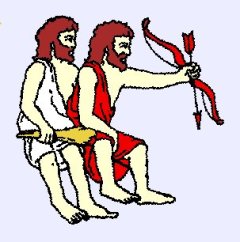 |
One note on the colors of their clothing shown in my illustrations, white for Pollux and red for Castor. Those colors seemed right for them long before the connection to Joseph Smith and Abel was discovered. They are shown in those colors in my article on the twelve stones.[25] Why? The colors for the Twins are those of Benjamin, being red and white, but which is which? Because it seemed clear that the twins represent Christ at his first coming (lower earthly twin) and also at his second (higher, heavenly, resurrected twin), and the Savior will wear red at his second coming (Rev. 19:13), the higher twin was clothed in red. But now that turns out also to be perfect coloring for Pollux and Castor. Pollux is in white, being Joseph Smith, whose color is white, and Castor is Abel, dressed in red, the color of his father Adam. The attention to detail in all of the symbolism represented in these constellations is amazing.
6. Conclusion
When the 49 constellations are laid out in a seven by seven table, according to their position in the heavens, with seven of the zodiac constellations in the middle row, then several patterns emerge which imply design and foreknowledge. First, each column can readily be associated with the deeds of one of the seven angels. Second, each row can be associated with one of the seven kingdoms of earth, heaven and the underworld. Third, when that is done, there is a bright star in every constellation located where that angel did his most important work. That is thirteen stars in exactly the right places, with none left out. Fourth, several of the ancient star myths are clearly represented, which of course was known to the Greeks. What is new here is that the myths correlate very well to scriptural symbolism, especially in the case of Hercules and Perseus. The curious details of the latter, complete with a first vision in a sacred grove, being given a breastplate to look into and a sword, and receiving several needed gifts all fit amazingly well with the life of Joseph Smith. Thus it is concluded that the constellations not only testify of Christ, as discussed in last month’s article, but they also provide detailed witness of the heroic deeds of the seven chief angels who serve God.
Notes
- Pratt, John P. “Enoch’s Constellations Testify of Christ,” Meridian Magazine (23 Aug 2006).
- Pratt, John P., “The Lion and Unicorn Testify of Christ, Part II: The Four Royal Stars,” Meridian Magazine (5 Dec 2001).
- Pratt, John P. “Seven Trumpets,” Meridian Magazine (27 Aug 2002), section 2.
- Over twenty pages are devoted to the Pleiades in Allen, Richard H., Star Names: Their Lore and Meaning (New York: Dover, 1963), pp. 391-412, which is more than almost any other constellation.
- That interpretation is given by Pindar, quoted by Robert Graves, The Greek Myths (Baltimore: Penguin, 1960), vol 2, p. 154, footnote 6.
- Germanicus Caesar quoted by Ian Ridpath in Star Tales (New York: Universe Books, 1988) p. 102. This book is the best single source I know to relate accurately researched myths to the stars. Unless otherwise noted, it is the source of all the mythology quoted in this article.
- There were other minor adjustments to keep related constellations together, some of which share a star. For example, the Waterman and Southern Fish share the star Fomalhaut, so the Sea Goat was placed below both of them. Similarly, the Centaur and Beast are often considered one constellation and they were kept together, pushing the Altar into the first column. Hercules was kept with the Dragon because his foot is on its head, and the River was said to encircle the southern ecliptic pole and hence could be placed in any column. Other than those minor adjustments, none of which was more than one column or row, all of the constellations are in their exact places in the sky.
- Curiously, W. W. Phelps coined this same phrase, “Archer of Paradise,” to describe Parley P. Pratt, one of the first twelve apostles of the LDS Church. He coined titles for all the apostles immediately after the death of the Prophet Joseph Smith: “I know the Twelve, and they know me. Their names are Brigham Young, the lion of the Lord; Heber C. Kimball, the herald of grace; Parley P. Pratt, the archer of paradise; Orson Hyde, the olive branch of Israel; Willard Richards, the keeper of the rolls; John Taylor, the champion of right; William Smith, the patriarchal Jacob staff; Wilford Woodruff, the banner of the gospel; George A. Smith, the entablature of truth; Orson Pratt, the gauge of philosophy; John E. Page, the sun dial; and Lyman Wight, the wild ram of the mountain.” (Times & Seasons, 25 Dec 1844, 5:761). Several of these names fit the constellations well. “Herald of Grace” fits Enoch, who was the messenger, and who invented the graceful music of the harp. The “patriarchal staff” fits Moses and the Herdsman, and the “wild ram” matches the Ram in Peter’s constellations. Something rings true about these titles, and Brigham Young was often referred to as the Lion of the Lord. There is biography of Parley P. Pratt entitled The Archer of Paradise by Reva Stanley (Caldwell, Idaho: Caxton Printers, 1937).
- Jowett, George F., The Drama of the Lost Disciples (London: Covenant, 1970), p. 176, quoted in McBirnie, William S., The Search for the Twelve Apostles (Wheaton, Ill.: Tyndale House, 1973), p. 65-66.
- Pratt, John P. “Myth of Perseus” at www.johnpratt.com/items/astronomy/myths/perseus.html“.
- Oliver Cowdery, “Letter VIII,” Messenger and Advocate 2 (Oct. 1835), p. 196, quoted by Brett Holbrook, “The Sword of Laban as a Symbol of Divine Authority and Kingship,” Journal of Book of Mormon Studies vol 2, No. 1 (Spring, 1993), p. 59. As for the breastplate being “brass,” that was mentioned in an account by John Hyde in 1857 quoted by Holbrook on p. 60.
- Joseph and the three witnesses were shown the sword of Laban (D&C 17:1), along with the liahona (Alma 37:38), but it is unclear whether they were ever actually in Joseph’s possession. The sword was kept with the sacred treasures, which suggests that it was much more than just Laban’s personal weapon. It was more likely a treasure from the family of Joseph of which Laban was the guardian. Someday we may find out who fashioned it for what future purpose. For scholarly discussion of these possibilities, including the proposal that it was the sword of Joseph of Egypt and also that it may have traced back to Methuselah, the son of Enoch, see Brett Holbrook, “The Sword of Laban as a Symbol of Divine Authority and Kingship,” and Daniel N. Rolph, “Prophets, Kings, and Swords: The Sword of Laban and Its Possible Pre-Laban Origin,” two consecutive articles in Journal of Book of Mormon Studies vol 2, No. 1 (Spring, 1993), pp. 39-72 and 73-79. One reason for proposing that the sword symbolized the golden plates is that once when Joseph and Oliver were allowed to enter a cave within the hill where the plates had been found, they saw the sword of Laban “laid across the golden plates,” which is not where it had been on their previous visit when they had returned the golden plates there. Brigham Young explained that “it was unsheathed, and on it was written these words ‘This sword will never be sheathed again until the kingdoms of this world become the kingdom of our God and Christ.’ ” (18 June 1877, Journal of Discourses 19:38). On Tue 18 Jun 1844 (1 Tammuz PHC, 13 Jaguar SR), nine days before his martyrdom, the Prophet Joseph Smith used similar language. According to one account, “Said he, I will die for you. Drew his sword and raised it up to heaven and said it should never be sheathed again until Zion is redeemed” (Diary of Charles Lowell Walker, p. 524; compare to DHC 6:499 and several other accounts in Holbrook, p. 67). Perseus is shown in the heavens with his sword unsheathed, attacking.
- History of the Church, vol 1. p. 176 footnote.
- My two names for the twins, “Champion” and “Warrior,” were taken from Ridpath’s Star Paths, p. 68: “Castor was a famed horseman and warrior who taught Hercules to fence, while Polydeuces was a champion boxer.”
- For example, the Prophet writes in his journal for Mon 13 Mar 1843, that after he preached to the saints in Ramus on the previous day, that “I wrestled with William Wall, the most expert wrestler in Ramus, and threw him” (DHC 5:302). What other prophet do you know that accepts challenges to wrestle after having preached a sermon? One candidate might be Jacob, who was surprised to be thrown by an angel whose name was apparently Phanuel (Peniel), the name of Joseph Smith as an angel (Gen. 32:24-30).
- “There is one thing more, which I witnessed, I will relate: It was at the time Porter Rockwell was in jail, in Missouri. His mother went to see him at the jail, and the Missourians told her that if she would raise a certain amount of money and give them they would let her son go. Joseph started out to get the money. He came to a large crowd of young men who were wrestling, that being the popular sport in those days. Among the boys there was a bully from La Harpe, I believe. He had thrown down everyone on the ground who took hold of him. When Joseph came to the crowd he told them what he wanted, passed around the hat, raised what money he could and then went into the ring to take part with the young men and boys in their games. So he was invited to wrestle with this bully. The man was eager to have a tussle with the Prophet, so Joseph stepped forward and took hold of the man. The first pass he made Joseph whirled him around and took him by the collar and seat of his trowsers and walked out to a ditch and threw him in it. Then, taking him by the arm, he helped him up and patted him on the back and said. ‘You must not mind this. When I am with the boys I make all the fun I can for them.'” Calvin Moore, “Recollections” Juvenile Instructor 27 (1892), p. 255.
- Even the alternate red and white stripes of the sardonyx, the stone of the Twins, fit this proposal. See my “Twelve Sons, Twelve Stones,” Meridian Magazine (3 Aug 2005), Section 3.
- Graves, I:248.
- The three bright stars Mintaka, Alnilam and Alnitak form the belt of the Hunter. Both Mintaka and Alnitak mean “Belt or Girdle,” whereas Alnilam means “the String of Pearls.” See Kunitzsch, Paul and Smart, Tim, Short Guide to Modern Star Names and Their Derivations (Wiesbaden: Harrassowitz, 1986), p. 46. This pearl girdle caused some to think that the constellation was indeed the Queen of the Amazons, rather that her conqueror, and we find that Bellatrix in the left shoulder means “the Female Warrior.”
- Pratt, John P., “Decision Days Ahead,” Meridian Magazine (21 Jun 2006), Section 2.2.
- Pratt, John P., “Seven Trumpets,” Meridian Magazine (27 Aug 2002), Section 2.2.
- The age of 34 is mentioned in Jasher 50:15. Both are represented as horns of the Bull (Deut. 33:17) and hence born at same time of year. I have proposed that both were born on 3 Apr 1767 BC. See my “Twelve Sons, Twelve Constellations,” Meridian Magazine (13 Jul 2005), section 1.5.
- Pratt, John P., “Geological Evidence for the British Throne of David?” Meridian Magazine (2 June 2003), Section 2.
- In case the reader is wondering whether the names of the stars got mixed up or randomly assigned, there is independent evidence that the stars are correctly named. There is a tradition that the lion follows the twin which is the dragon slayer, and in the heavens, the Lion follows Pollux, who is Joseph Smith, being Perseus, the slayer of the Medusa and the Sea Monster. A similar legend was preserved in the Nordic legend of Sigurd and Brunhild, being the same as the German tradition of Siegfried and Brumhilda, which was the basis of Wagner’s opera “Ring of the Nibelungs.” In that tradition there is no lion and the brothers are not twins, but one wears a mask which makes him look exactly like the other. It also lost the happy ending to the story.
- Pratt, John P., “Twelve Sons, Twelve Stones,” Meridian Magazine (3 Aug 2005), section 5.1.

